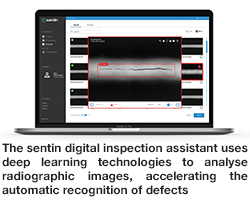Automatic defect recognition in digital radiography based on artificial intelligence
06/01/2020
Sentin GmbH has made it its mission to automate error detection in visual and image-based inspections with deep learning technologies. The German tech company has developed a digital inspection assistant in cooperation with Applus+ RTD, one of the world’s leading NDT service providers in the energy sector, and VISUS Industry IT, a provider of industrial image management software (JiveX). The main benefits of the software system are an objective opinion on critical images and more time for crucial cases. Thus, the increasingly digital inspection can be accelerated by the automatic recognition of defects. In the automatic inspection of radiographic images, rule-based image processing quickly reaches its limits due to the complex defect patterns of the weld seams. A further problem with the interpretation is the different brightness levels, which result from the manual image acquisition as well as the size of the defects. Under some conditions, it can even be difficult for skilled inspectors to correctly interpret a small speck or spot, or to create the correct image ratios for a proper assessment. However, studies on the evaluation of X-ray images from the medical field have already shown that deep learning methods evaluate images faster and over 20% more accurately than human experts. Thus, sentin uses deep learning technologies to analyse the radiographic images.
The main benefits of the software system are an objective opinion on critical images and more time for crucial cases. Thus, the increasingly digital inspection can be accelerated by the automatic recognition of defects. In the automatic inspection of radiographic images, rule-based image processing quickly reaches its limits due to the complex defect patterns of the weld seams. A further problem with the interpretation is the different brightness levels, which result from the manual image acquisition as well as the size of the defects. Under some conditions, it can even be difficult for skilled inspectors to correctly interpret a small speck or spot, or to create the correct image ratios for a proper assessment. However, studies on the evaluation of X-ray images from the medical field have already shown that deep learning methods evaluate images faster and over 20% more accurately than human experts. Thus, sentin uses deep learning technologies to analyse the radiographic images.When developing a deep learning model, it must be trained to recognise different types of defect, which the system then learns automatically. A weld seam can have internal and external defects that are divided into approximately ten categories. By correctly classifying the data with bounding boxes, the system learns to identify the most common types of defect, such as cracks, pores, incomplete penetration, splashes or inclusions. Using so-called transfer learning, in which a model that can already solve a similar problem serves as a starting point, a highly accurate model can be trained with just a few dozen examples. Thus, the whole system can be quickly applied. During training, it is important to ensure that the rate of false negative classifications (overlooked errors) is as low as possible. For an application in the aviation sector, the developed system has already achieved an accuracy of over 99.9% probability of detection (POD).
www.sentin.ai